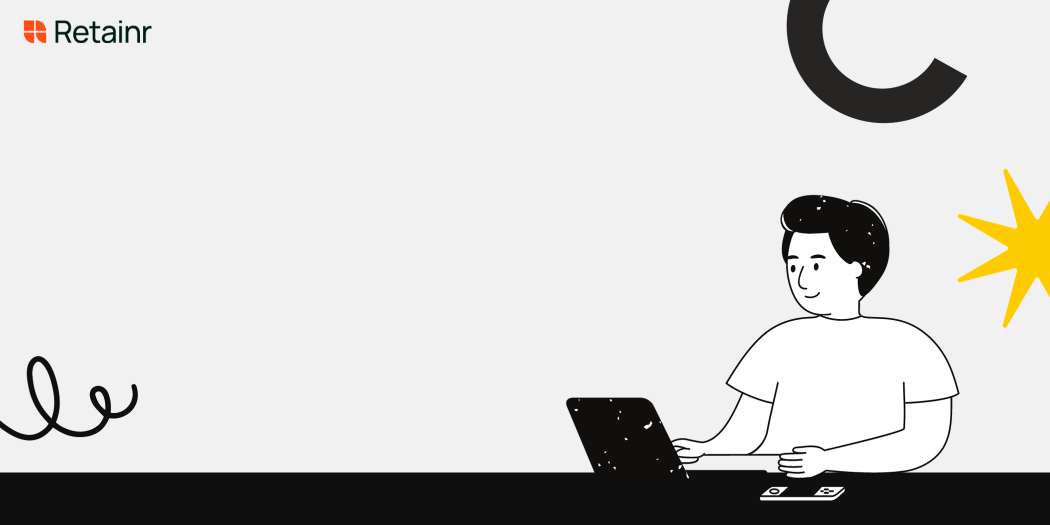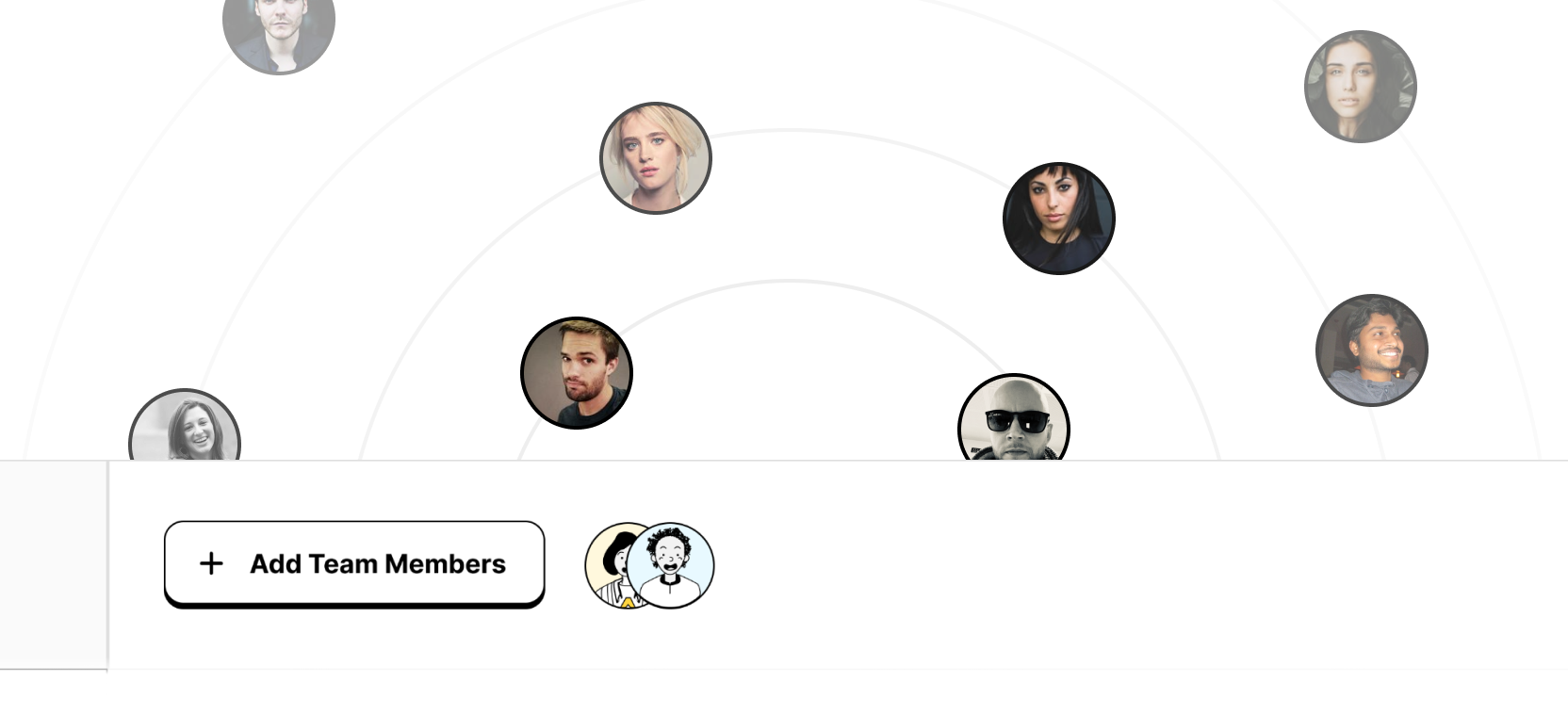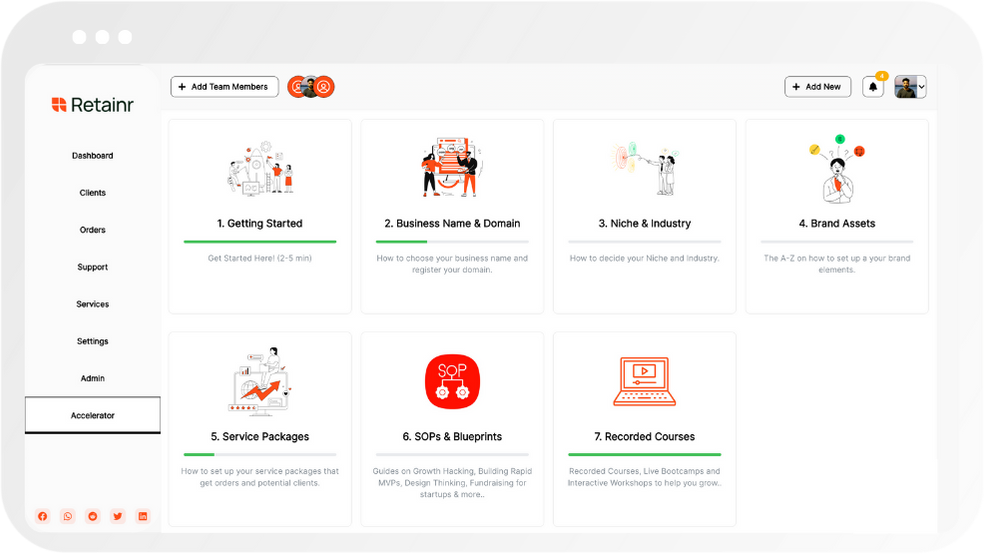
7 Ways To Improve Remote Team Communication
Build with Retainr
Sell your products and services, manage clients, orders, payments, automate your client onboarding and management with your own branded web application.
Get Started1. What are the top 7 ways to improve remote team communication?
Effective Tools for Enhanced Remote Communication
Improving remote team communication is dependent on the various tools that facilitate synchronous and asynchronous communication. The top tools include Slack for instant messaging, Zoom or Google Meet for video conferencing, Asana or Trello for project management, Google Sheets or Excel for data management. Furthermore, tools like Notion, Google Docs, and Evernote can be used for taking and sharing notes.
| Tool | Type |
|---|---|
| Slack | Instant Messaging |
| Zoom/Google Meet | Video Conferencing |
| Asana/Trello | Project Management |
| Google Sheets/Excel | Data Management |
| Notion/Google Docs/Evernote | Note-taking |
Practices for Better Remote Team Communication
Apart from using effective tools, adopting certain practices can dramatically improve remote team communication. These include over-communication to ensure all team members are on the same page, regular check-ins to foster team engagement, clear documentation to avoid confusion, assigning team leaders for increased accountability, setting communication norms to maintain decorum, providing feedback for improvement, and practicing transparency to build trust.
- Over-Communication
- Regular Check-ins
- Clear Documentation
- Assigning Team Leaders
- Setting Communication Norms
- Providing Feedback
- Practicing Transparency
Investing in Team Building and Training Sessions
Investments in team building and training sessions focusing on remote team communication can yield significant improvements. Team building sessions encourage camaraderie and foster open communication. On the other hand, training sessions help team members learn the best communication practices for remote work. A simple training on how to use communication tools and honing communication skills can go a long way in enhancing remote team communication.
2. Why is improving communication within a remote team important?
The Importance of Improved Communication in Remote Teams
In the era of remote work, improving communication within a remote team is crucial for several reasons. Firstly, it enhances productivity. With clear and efficient communication, team members can understand their tasks and responsibilities, reducing confusion and misunderstandings. Secondly, improved communication fosters better teamwork. Teams that communicate better tend to have stronger relationships, leading to better collaboration and higher team morale. Thirdly, it reduces the risk of delays and errors. When everybody is aware of what others are doing and the status of their tasks, possible misalignments or issues can be identified and addressed promptly.
Table of the Importance of Communication in Remote Teams
| Aspect | Benefit |
|---|---|
| Productivity | Understanding tasks and responsibilities effectively minimize confusion and misinterpretations. |
| Teamwork | Better relationships are built leading to stronger collaborations and high team morale. |
| Delays and Errors | Reduces the risk by making everyone aware of each other's tasks, enabling early identification and addressing of issues. |
A Summary
To summarize, good communication results in improved teamwork, higher productivity, and lesser delays or errors. It holds remote teams together, ensuring everyone is moving in the same direction and contributes significantly to team success. Furthermore, it helps in building trust among team members, vital in bridging the physical gap caused by remote work. It aids in creating a positive work environment and improves job satisfaction among team members. Hence, investing time and efforts in improving communication within a remote team is undoubtedly beneficial.
3. What tools or software can help improve remote team communication?
Communication Tools and Software for Remote Teams
The choice of tools or software plays a crucial role in ensuring clear communication in remote teams. There are numerous tools available, each with unique features and strengths.
- Slack: Popular for its instant messaging capabilities, Slack allows team members to send direct messages or create themed channels for group conversations. It also allows file sharing and integrates with other tools like Google Drive.
- Zoom: Best known for video conferencing, Zoom allows teams to have scheduled or impromptu face-to-face meetings. It also has features for sharing screens, recording meetings, and creating breakout rooms.
- Microsoft Teams: This multifunctional tool provides a platform for team chats, video meetings, and file storage. Teams can also be used for collaborative work within Microsoft Office documents.
- Asana: As a project management tool, Asana helps teams to plan, organize and track the progress of tasks. It visualizes timeline and workload which improve communication about task expectations and deadlines.
Comparison of Communication Tools
Each of these tools has its strengths and weaknesses, and teams may choose one over the other based on their specific needs. Here's a comparative table to assist in making a decision.
| Tool | Best for | Key Features |
|---|---|---|
| Slack | Instant Messaging | Themed channels, File sharing, Integration with third-party applications. |
| Zoom | Video conferencing | Screen sharing, Recording meetings, Creating breakout rooms. |
| Microsoft Teams | All-round communication | Team chats, Video meetings, Collaborative work within Microsoft Office documents. |
| Asana | Task management | Plan, organize and track tasks, Visualize timeline and workload. |
Choosing the Right Communication Tool
While choosing a software, consider factors such as your team's size, the frequency of interaction required, and the nature of the tasks to be communicated. Ensure that the chosen tool is user-friendly and provides support for any technical issues that might arise. Flexibility and customization options can also enhance the user experience and thus, improve overall communication.
4. Can these methods of improving remote team communication be easily implemented?
Effortless Implementation of Remote Team Communication Methods
Some people may see the implementation of new methods to enhance remote team communication as a complex process. On the contrary, these methods can be easily adopted and incorporated into daily team activities. The extent to which an organization succeeds in this will largely depend on the company's culture, technological capabilities and willingness to adapt to changes.
Factors Facilitating Easy Implementation
- Technological Advancements: In the ever-evolving digital era, the availability and accessibility of numerous communication tools like Slack, Microsoft Teams, Zoom etc. allow for seamless integration and implementation of improved remote communication strategies.
- Training and Onboarding: Offer training sessions to team members on how to effectively use these tools for communication. This includes setting up meetings, sharing files, sending instant messages, etc.
- Company Culture: A culture of openness and acceptance to change can drastically improve the ease of implementing new communication methods. If a company culture promotes innovation and adaptability, team members are more likely to embrace these changes.
Comparison of Implementation Efforts
| Communication Tool | Implementation Process | Difficulty Level |
|---|---|---|
| Slack | Sign up, Install app, Create channels, Invite team members | Easy |
| Microsoft Teams | Sign up, Install software, Set up Teams, Invite team members | Moderate |
| Zoom | Sign up, Download app, Schedule meetings, Share meeting links | Easy |
5. How does improving communication amongst remote teams increase productivity?
Enhanced Communication for Productivity
Enhancing communication among remote teams directly boosts productivity as it positively alters many operations in the remote work setting. Primarily, ensuring regular and effective communication helps to streamline workflows, encourage individual and team accomplishments, and increase the overall work quality.
- Streamlined Workflows: Consistent communication enables all team members to be on the same page, effectively eliminating confusion, delays or rework caused by miscommunication. Tasks are clearly defined and everybody understands their roles and responsibilities, ultimately speeding up processes and productivity.
- Encourages Team Performance: Effective communication fosters a climate of trust and understanding, thus motivating team members to work towards a common goal. This positive environment nurtures creativity and individual contribution, which significantly improves the team's performance and productivity.
- Boosts Work Quality: When there's a good flow of communication within the team, it becomes easier to maintain high standards of work. Team members can easily share ideas and feedback, helping each other to improve the quality of their work.
The Correlation Table
The table below illustrates the correlation between enhanced communication and increased productivity in a remote team setup:
| Enhanced Communication | Increased Productivity |
|---|---|
| Streamlined Workflows | Elimination of confusion, delays and rework |
| Encourages Team Performance | Fosters trust, understanding and motivation |
| Boosts Work Quality | Enhancement of work standards through shared ideas and feedback |
Therefore, boosting communication within remote teams is a sure-fire way to increase productivity. By focusing on ensuring that everyone clearly comprehends their tasks, fostering a positive working environment and encouraging shared input on work quality, remote teams can fully harness the benefits of improved communication to increase their output.
6. Are there any tried and tested strategies for improving remote team communication?
Establish Clear Channels of Communication
One of the focal strategies to improve remote team communication is the establishment of clear communication channels. This begins with understanding that not all communication platforms are suitable for every type of messaging. Thus, it may help to categorize these channels based on their functionality. For instance:
- Fast-paced discussions: Platforms like Slack or Skype can be used where quick responses are required.
- Long-term projects: Tools such as Trello or Asana would be appropriate for tasks that have a lengthy timeline or a lot of moving parts.
- Formal communication: Emails or company intranet sites can be designated for company-wide announcements or formal messaging.
Effective Time Management
Ensuring everyone is respectful of each other's time is another essential strategy. Many remote workers juggle diverse time zones, reducing the overlap of work hours. Therefore, meetings should be planned to accommodate everyone or recorded for those who can’t attend live. A timetable can be useful for understanding the convenient timings for each member. Here's an example of a schedule:
| Team Member | Location | Working Hours |
|---|---|---|
| Member 1 | California, USA | 9:00 AM - 5:00 PM PDT |
| Member 2 | London, UK | 9:00 AM - 5:00 PM BST |
Encourage Feedback
Encouraging feedback is a powerful strategy for better communication. It's paramount to not only encourage team members to provide feedback but also make them act on the received feedback. The feedback can be related to the team's remote communication practices or about the projects at hand.
- Polling Tools: Implement real-time polling tools during team meetings to collect feedback anonymously.
- Regular Surveys: Conduct regular team surveys about communication and team collaboration effectiveness.
- One-on-one meetings: Arrange private meetings between team leaders and members to share feedback in a more personal setting.
7. Can these methods also promote better relationships among team members?
Methods Promoting Better Relationships among Team Members
These methods of improving remote communication can also significantly contribute to building better relationships among teams members. These positive shifts in team dynamics are often due to improved understanding, greater transparency, and the creation of shared goals.
How Methods Foster Understanding, Transparency, and Shared Goals
- Improved Understanding: Techniques such as regular video meetings and channels for casual conversation can allow team members to see facial expressions and hear vocal tones. These are vital non-verbal cues that can lead to better understanding among the team.
- Greater Transparency: The use of project management tools and regular progress reports instill a culture of accountability and transparency. This leads to greater trust among team members, thereby strengthening relationships.
- Shared Goals: Shared calendars, task lists, and visual project timelines can create clear visibility on team targets, leading to a collective sense of purpose and shared goals.
Visual Representation of Relationship Promotion
| Methods | Ways of promoting better relationships |
|---|---|
| Video Meetings & Casual Conversation Channels | Improved understanding |
| Project Management Tools & Progress Reports | Greater transparency |
| Shared Calendars & Project Timelines | Shared goals |
8. How can managers or leaders facilitate better communication in remote teams?
Establish Clear Communication Channels
Effective communication in remote teams greatly depends on the establishment of clear communication methods. Managers can make use of various digital tools such as Skype, Zoom, and Slack for team meetings, one-on-one check-ins, and project discussions. A good practice is to label and dedicate channels for specific tasks or topics to prevent confusion.
- General Channel: For company-wide announcements and updates.
- Team Channel: Where specific teams can focus on their tasks and objectives.
- Project Channel: Created specifically for project-based discussions.
Promote Regular Feedback
Developing a culture of regular feedback helps in identifying communication gaps and improving the efficiency of the remote team. By using tools for anonymous feedback or scheduled check-ins, managers can ensure that team members feel heard and valued. It's important to clearly state that the purpose is to improve team communication and not to point fingers or blame.
| Feedback Tool | Benefit |
|---|---|
| Anonymous feedback tools | Encourages honesty and prevents fear of retaliation |
| Scheduled check-ins | Maintains open lines of communication and transparency |
Emphasize on Building Trust
The success of remote teams often lies in the level of trust among team members. Leaders can facilitate this by making sure communication is transparent, rules are clear, and everyone is held accountable. Some strategies for building trust include:
- Conducting regular virtual team building activities.
- Encouraging open discussion and idea sharing.
- Implementing a fair and transparent performance evaluation system.
9. What challenges might teams face when trying to implement these strategies for improved communication?
1. Technical Issues
One of the main challenges teams might face when trying to implement strategies for improved communication is technical issues. These can range from unstable internet connections and problematic software to lack of proper equipment and tools, which may hinder smooth communication.
- Unstable Internet Connection: Inadequate internet connection can cause poor audio or video quality during virtual meetings, leading to miscommunication.
- Problematic Software: Software glitches and bugs might cause frequent interruptions, difficulty accessing shared documents or non-functional features that may slow down the process.
- Lack of Equipment: Some team members might not have the necessary devices or tools needed for the adopted method of communication.
2. Resistance to Change
Resistance to implementing new communication strategies can also pose a big challenge. For some team members, adjusting to new routines and means of communication might be difficult, creating resistance to adapt and implement new strategies.
- Adapting to technology: Some individuals may find it challenging to adapt to new digital tools, thus affecting the adoption of new strategies.
- Change of routine: Implementing new processes often involves changes in routine, which some team members may resist.
- Misalignment of understanding: There might be misunderstandings or misinterpretations over the purpose and implementation of new strategies.
3. Maintaining Consistency
The challenge of maintaining consistency in communication can arise as some team members may not fully adopt the improved practices. This inconsistency can lead to confusion and reduced productivity.
| Factors | Issues |
|---|---|
| Follow Through | Team members may not consistently apply new methods of communication. |
| Time Zone Differences | Teams spread across multiple time zones may find scheduling meetings more complicated. |
| Language Barriers | If a team is multilingual, language barriers can hamper effective communication. |
10. How long should it take to see improvements in team communication after implementing these techniques?
Timeline for Improvements in Team Communication
The duration it takes to see notably enhanced team communication after executing these tactics is subjective and depends on numerous variables. Yet, the majority of teams note some level of improvement within one to three months of being consistent with implementing and practicing new communication methods.
- One Month: With consistent application, slight improvements in team communication can typically be observed within the first four weeks. This may look like clearer, more frequent communication or increased usage of designated communication platforms. This is the beginning phase where new habits are being formed and the team is getting used to the introduced changes.
- Two Months: By the second month, the teammates are often more comfortable with the new techniques and are likely utilizing them more effectively. The results of this may include fewer misunderstandings, quicker response times, or more productive meetings.
- Three Months: By the end of the third month, the changes in communication should be quite evident. The team would have now fully adapted to the implemented techniques which will reflect in the smooth, clear and efficient flow of communication.
Progress Monitoring
Use tangible measurements to track and evaluate the effectiveness of the implemented techniques. This could be done through surveys or feedback sessions to understand team member experiences and gauge improvements. An illustrative table could look like the below:
| Time Period | Changes Implemented | Feedback/Results |
|---|---|---|
| Month 1 | Implement use of communication platforms | Increased frequency of communication |
| Month 2 | Regular check-in meetings | Fewer misunderstandings, quicker problem-solving |
| Month 3 | Consistent practice and review of all techniques | Smooth, efficient flow of communication |
Continual Improvement
Remember, improving team communication is an ongoing process. Even after seeing improvements, it's essential to continually assess and refine these techniques to suit the team's evolving needs. This ensures communication remains effective and collaborative in a remote environment.
Conclusion
Effective Strategies to Enhance Remote Team Communication
Facilitating seamless communication within a remote team can be challenging but there are several strategies that can significantly improve the process. Firstly, setting clear expectations and guidelines for communication can provide a framework for productive interactions. Secondly, regular team meetings are crucial for keeping everyone on the same page and fostering team spirit. Thirdly, using instant messaging tools can enhance day-to-day communication.
Fourthly, creating a virtual water cooler, where team members can connect on a personal level, encourages open communication. Additionally, providing constructive feedback can facilitate continuous learning and improvement. Meanwhile, it's important to respect personal boundaries to avoid burnout. Finally, utilizing appropriate tech tools can streamline communication and make remote work more efficient.
Enhancing Remote Communication with Retainr.io
In order to embrace and effectively implement these strategies, it's critical to choose suitable software. Retainr.io is one such comprehensive white-label software solution designed to manage clients, orders, and payments – all from your own branded app. Not only does it cater to your unique business needs, but it can also radically improve communication within your remote team.
This highly customizable platform facilitates real-time communication, making team discussions, client interactions, and order management more effective – even in a remote setting. Whether planning regular meetings or providing constructive feedback, Retainr.io makes it easier than ever. Its user-friendly interface ensures a smooth experience for all team members, simplifying the transition to remote work. Invest in Retainr.io and watch your team’s communication thrive.
Boost Your Agency Growth
with Retainr Accelerator
Uncover secrets, strategies, and exclusive blueprints to take your agency's growth to the next level — from marketing insights to effective presentations and leveraging technology.

SOPs, Cheatsheets & Blueprints
Leverage 50+ SOPs (valued over $10K) offering practical guides, scripts, tools, hacks, templates, and cheat sheets to fast-track your startup's growth.
Connect with fellow entrepreneurs, share experiences, and get expert insights within our exclusive Facebook community.
.jpg)

Join a thriving community of growth hackers. Network, collaborate, and learn from like-minded entrepreneurs on a lifelong journey to success.

Gain expertise with recorded Courses, Live Bootcamps and interactive Workshops on topics like growth hacking, copywriting, no-code funnel building, performance marketing and more, taught by seasoned coaches & industry experts.

.jpg)

.jpeg)


